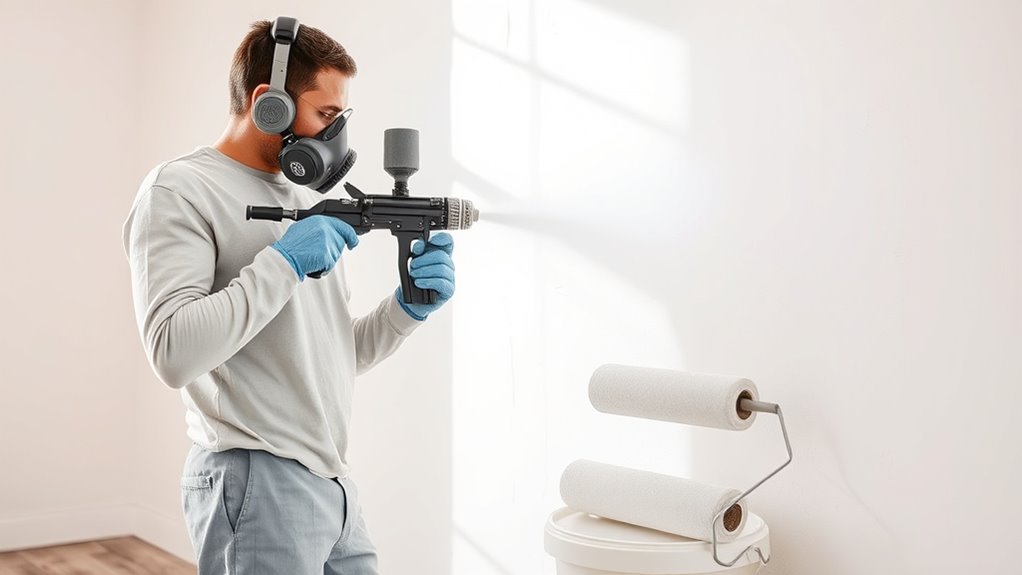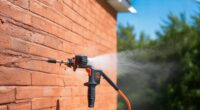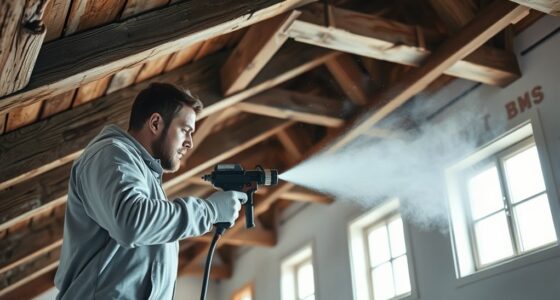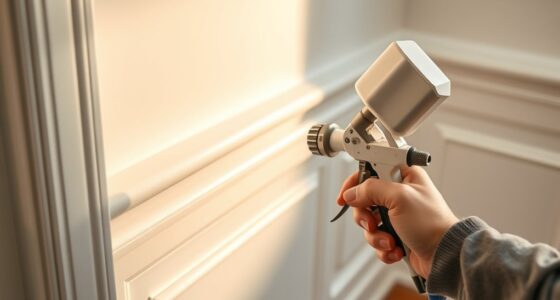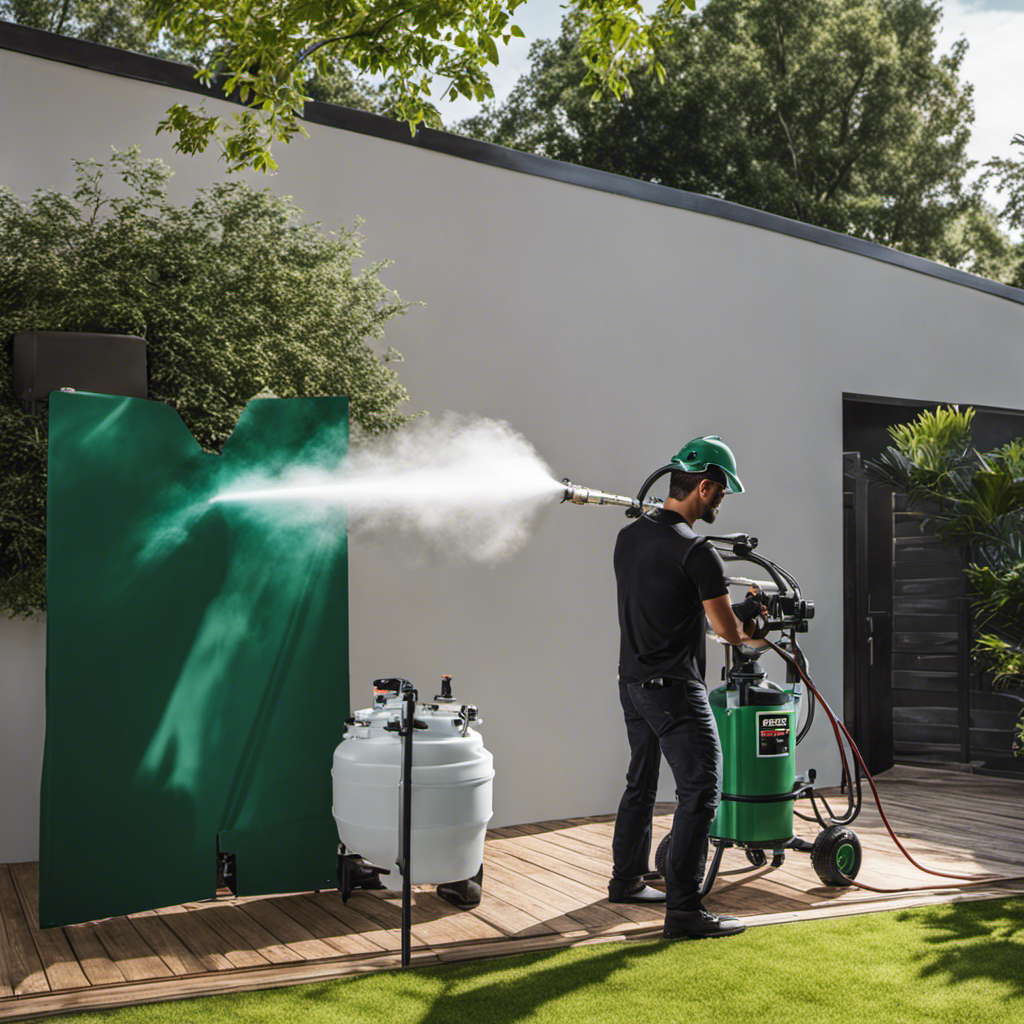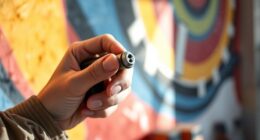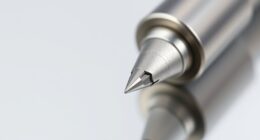After spraying, you should backroll while the paint is still wet to guarantee even coverage and proper adhesion. The right timing depends on factors like surface texture, paint type, and environmental conditions. Look for signs such as uneven coverage, streaks, or rough patches—these indicate it’s time to backroll. Using proper techniques and tools helps achieve a smooth finish. To learn more about optimizing your process, keep exploring expert tips and best practices.
Key Takeaways
- Backroll immediately after spraying while the paint remains wet for optimal leveling and adhesion.
- Surface texture and paint type dictate the ideal timing for backrolling, especially on textured or porous surfaces.
- Environmental conditions like humidity and temperature influence drying times, affecting when to backroll.
- Signs such as streaks, uneven coverage, or surface roughness indicate it’s time to backroll.
- Proper technique and tools, applied promptly after spraying, ensure a smooth, durable, professional finish.
Factors That Influence the Timing of Backrolling

The timing of backrolling depends on several key factors that can affect its effectiveness. One major factor is the surface texture; rough surfaces like stucco or textured drywall may require earlier backrolling to ensure paint penetrates evenly. Smooth surfaces, on the other hand, might allow for a longer wait before backrolling. Additionally, the type of paint used plays a significant role. Thicker paints, such as heavy-duty or elastomeric coatings, often need to be backrolled sooner to prevent drips and ensure proper adhesion. Conversely, lighter or fast-drying paints might not need as immediate a backroll. Understanding these factors helps you decide the most suitable moment to backroll, ensuring a smooth, even finish and reducing the risk of missed spots or uneven coverage. Proper timing also depends on paint drying times, which can vary based on environmental conditions, paint formulation, and application techniques, all of which influence how quickly the paint sets and cures. Being aware of paint curing process and how it interacts with surface texture can further optimize your painting schedule and results. Additionally, considering climate conditions such as humidity and temperature can significantly impact the drying and curing process, helping you choose the optimal time for backrolling.
Signs That Indicate It’s Time to Backroll

Knowing when to backroll is key to achieving a smooth, even paint job. If you notice uneven color matching or streaks after spraying, it’s a sign you should backroll. Poor surface preparation can cause paint to settle unevenly, making backrolling necessary to even out the finish. Additionally, if the sprayed surface feels rough or textured, it indicates that the paint hasn’t leveled properly and needs smoothing with a backroll. Watch for areas where the spray coverage appears inconsistent or where drips and runs form; these imperfections often require backrolling to blend the paint seamlessly. Proper filtration and pump protection can also influence the need for backrolling, as they help maintain consistent paint flow and surface quality. Recognizing these signs early helps ensure a professional-looking result and prevents costly rework. Understanding paint flow dynamics can further help in assessing whether backrolling is needed, as inconsistent flow can lead to uneven coverage. Additionally, monitoring surface preparation techniques is crucial, as improper prep can increase the likelihood of needing to backroll. Being attentive to environmental conditions like temperature and humidity can also impact how the paint settles and whether backrolling is necessary. Sometimes, paint consistency issues due to incorrect mixing can also cause the need for backrolling. Trust your observations — they’re your best guide for knowing when to backroll.
Techniques for Effective Backrolling After Spraying

To backroll effectively after spraying, you need to choose the right tools, like a quality roller or brush, for smooth and even coverage. Maintaining a consistent application technique guarantees the paint spreads evenly and reduces streaks. Focus on these key points to improve your backrolling results and achieve a professional finish.
Proper Tool Selection
Choosing the right tools for backrolling after spraying can substantially impact the quality of your finish. You need a roller that matches your paint’s consistency—thicker paints require nap rollers, while thinner paints work best with shorter naps. Proper equipment calibration guarantees even coverage and prevents roller splatters or streaks. Before starting, check that your roller covers are clean and free of debris. Use a high-quality roller frame that provides consistent pressure and control. Selecting the appropriate tools also means ensuring your roller is suitable for the surface you’re painting, whether smooth or textured. By focusing on paint consistency and equipment calibration, you’ll achieve a smooth, professional finish that complements your spraying job and minimizes touch-ups. Additionally, understanding AI-powered virtual reality in e-learning can help in planning your projects more effectively by visualizing the final outcome beforehand. It is also important to consider the symptoms of breast cancer to stay informed about health risks that could affect your work schedule or safety precautions when working in environments related to health facilities. Proper hybrid bicycle maintenance techniques can also serve as a useful analogy for maintaining your painting tools, ensuring longevity and optimal performance. Paying attention to the dog names you choose can help reflect your personal style and make your pet feel more connected to your home environment.
Consistent Application Technique
After selecting the right tools, maintaining a consistent application technique during backrolling guarantees a smooth and even finish. Focus on controlling your paint consistency to prevent drips and uneven coverage. Keep your spray angle steady to ensure uniform application before backrolling. To achieve this:
- Maintain a consistent spray angle throughout the process.
- Check that your paint consistency remains steady, avoiding too thick or thin mixes.
- Use smooth, overlapping strokes when backrolling to blend areas seamlessly.
- Keep your backrolling speed uniform to avoid streaks or missed spots.
- Incorporate interior design principles to enhance overall room harmony and visual appeal.
- Be mindful of paint adhesion to ensure the coating bonds properly and lasts longer. Additionally, paying attention to paint drying times can prevent smudging or rework, ensuring a professional finish. Recognizing how creative practice influences your technique can also help you develop more effective application skills. Paying attention to paint quality can further improve the durability and appearance of your paint job.
Sticking to these techniques ensures your paint application is even, eliminating inconsistencies and producing professional results. Consistency in your approach makes all the difference in achieving a flawless, durable finish.
Benefits of Backrolling in Ensuring Even Coverage

Backrolling plays an essential role in achieving uniform paint coverage, especially in areas where spraying alone might leave streaks or thin spots. It helps to improve paint adhesion by pressing the paint into the surface, ensuring a consistent layer. Proper surface preparation before backrolling removes dust, grease, and uneven patches, which enhances the evenness of coverage. When you backroll, you distribute the paint more thoroughly, reducing the risk of lap marks and missed spots. This technique also helps the paint to settle evenly, resulting in a smoother finish. Overall, backrolling complements spraying by filling in gaps and leveling out the coating, making your final paint job more durable and visually appealing. It’s a crucial step for achieving professional-quality results. Additionally, understanding paint application techniques can help you decide when backrolling is most beneficial for your project.
Common Mistakes to Avoid When Backrolling
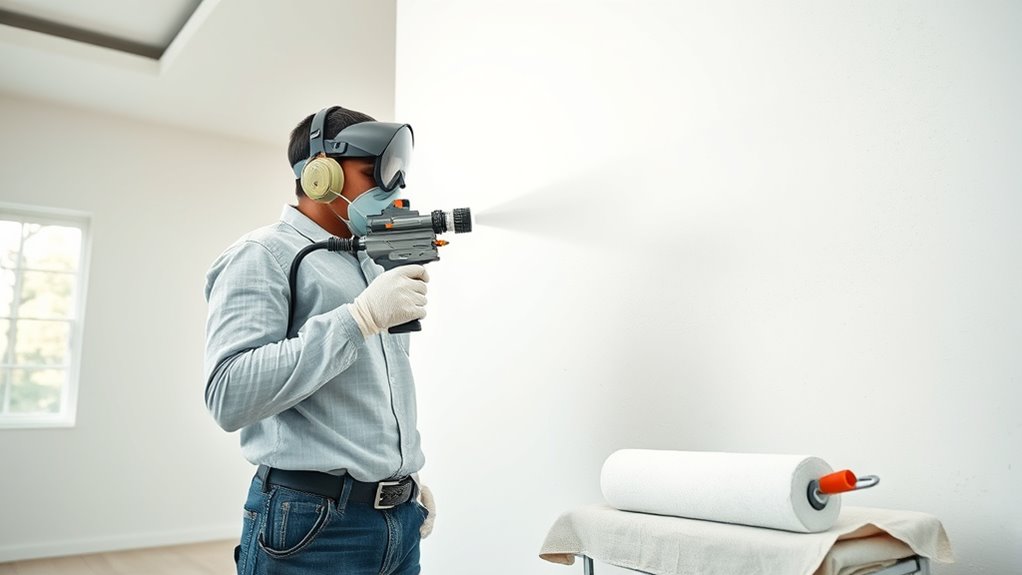
To achieve a smooth and even finish when backrolling, it’s essential to avoid common mistakes that can compromise your results. First, don’t rush the process; applying too much pressure can cause uneven paint adhesion. Second, avoid overworking the area, which can lead to roller marks and inconsistent paint sheen. Third, skip the step of maintaining a wet edge, as this can cause lap marks and uneven coverage. Fourth, neglect to use the right nap roller for your paint type—using the wrong one can affect the paint’s adherence and finish. By paying attention to these mistakes, you’ll ensure proper paint adhesion and a uniform paint sheen, resulting in a professional-looking paint job that lasts. Additionally, understanding tuning techniques can help optimize your equipment for the best application results.
Best Practices for Combining Spraying and Backrolling
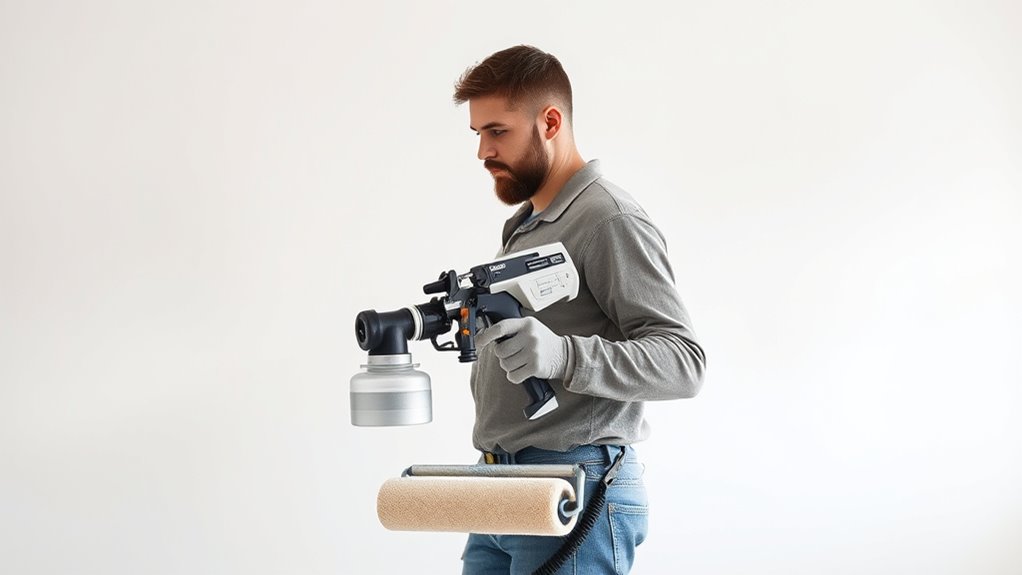
Combining spraying and backrolling can produce a smoother, more professional finish when painting large surfaces. To do this effectively, start with quality spray equipment suited for your project. Adjust the spray pressure based on paint viscosity; thinner paints spray more evenly, reducing drips and overspray. Apply the paint in even, overlapping passes to ensure consistent coverage. Once the surface is coated, backroll immediately to smooth out the paint and work it into the surface, especially on textured or porous areas. Keep a wet edge to avoid lap marks and maintain a uniform appearance. Remember, the key is timing—backroll promptly after spraying while the paint remains wet, which helps achieve a flawless, durable finish.
Frequently Asked Questions
How Long Should I Wait Before Backrolling After Spraying?
You should wait until the paint is dry to the touch, usually about 1-2 hours after spraying, before backrolling. This guarantees proper surface preparation and prevents smudging or uneven coverage. Rushing the process can damage the finish or cause paint to peel. Always follow the manufacturer’s drying times, and consider environmental factors like temperature and humidity, which can affect paint drying and your timing for backrolling.
Can I Backroll With Different Paint Types Than I Sprayed?
You might think switching paint types mid-project is like mixing oil and water—impossible, right? Well, it’s not impossible, but you gotta consider paint compatibility and drying time. Different paints have varying formulas, so backrolling with a different type than you sprayed can cause adhesion issues or uneven finish. Always check manufacturer recommendations, wait for proper drying, and verify the new paint is compatible to get a smooth, durable result.
What Equipment Is Best Suited for Backrolling?
You should choose equipment suited for backrolling based on your project needs. Use a high-quality roller with the right nap length for your surface—foam or lambswool rollers work well for smooth textures, while thicker nap rollers are better for rough surfaces. Make certain your spray equipment is compatible with your roller types, making transitions smooth and efficient. This combination helps you achieve a uniform finish and optimal paint coverage.
Is Backrolling Necessary for All Wall Surfaces?
Like a knight in shining armor, you wonder if backrolling is necessary for all wall surfaces. It depends on surface texture and paint adhesion. Smooth surfaces often don’t need it, but rough or textured walls benefit from backrolling to ensure even coverage and better adhesion. You should evaluate each surface individually; not every wall requires backrolling, but it’s a good step for durability and a flawless finish.
How Does Humidity Affect the Timing of Backrolling?
Humidity effects markedly influence your painting process. Higher humidity slows down the drying time, meaning you should wait longer before backrolling to avoid smudging or uneven finishes. Conversely, low humidity speeds up drying, allowing you to backroll sooner. Keep an eye on the environment, and don’t rush the process—adjust your timing accordingly to ensure a smooth, durable coat without issues caused by excess moisture.
Conclusion
Choosing when to backroll after spraying depends on factors like paint type, surface, and spray technique. Recognize the signs that indicate it’s time, apply effective backrolling methods, and avoid common mistakes. By combining spraying and backrolling thoughtfully, you ensure even coverage, better adhesion, and a professional finish. Ultimately, it’s about timing, technique, and attention—timing to prevent drips, technique to achieve smoothness, and attention to detail for perfection.
A seasoned painter with over 15 years in the industry, Mike transitioned from hands-on painting projects to the digital world of paint sprayers. His extensive experience gives him a unique perspective on what users truly need when it comes to painting tools. As the Editor in Chief of Paint Sprayer Zone, Mike ensures that every piece of content not only provides value but also reflects the realities of painting — the challenges, the joys, and the intricate details.
